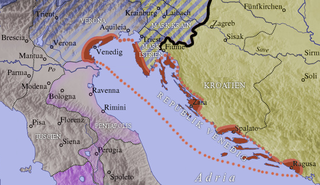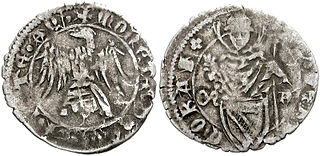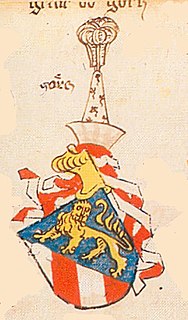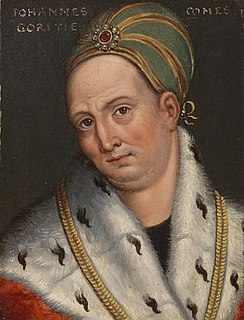
Henry of Gorizia, a member of the House of Gorizia, was Duke of Carinthia and Landgrave of Carniola and Count of Tyrol from 1295 until his death, as well as King of Bohemia, Margrave of Moravia and titular King of Poland in 1306 and again from 1307 until 1310. After his death, the Habsburgs took over Carinthia and Carniola and held them almost without interruption until 1918.

Albert I, a member of the House of Gorizia, ruled the counties of Gorizia (Görz) and Tyrol from 1258, jointly with his elder brother Meinhard IV. In 1271, the brothers divided their heritage and Albert became sole ruler of the Gorizia estates until his death. His descendants, known collectively as the Albertine line, ruled the County of Gorizia until the extinction of the House in 1500.

The Patriarchate of Aquileia was an episcopal see in northeastern Italy, centred on the ancient city of Aquileia situated at the head of the Adriatic, on what is now the Italian seacoast. For many centuries it played an important part in history, particularly in that of the Holy See and northern Italy, and a number of church councils were held there.

The County of Gorizia, from 1365 Princely County of Gorizia, was a State of the Holy Roman Empire. Originally mediate Vogts of the Patriarchs of Aquileia, the Counts of Gorizia (Meinhardiner) ruled over several fiefs in the area of Lienz and in the Friuli region of northeastern Italy with their residence at Gorizia (Görz).

The Counts of Gorizia, also known as the Meinhardiner, were a comital, princely and ducal dynasty in the Holy Roman Empire. Named after Gorizia Castle in Gorizia, they were originally "advocates" (Vogts) in the Patriarchate of Aquileia who ruled the County of Gorizia (Görz) from the early 12th century until the year 1500. Staunch supporters of the Emperors against the papacy, they reached the height of their power in the aftermath of the battle of Marchfeld between the 1280s and 1310s, when they controlled most of contemporary Slovenia, western and south-western Austria and north-eastern Italy mostly as (princely) Counts of Gorizia and Tyrol, Landgraves of Savinja and Dukes of Carinthia and Carniola. After 1335, they began a steady decline until their territories shrunk back to the original County of Gorizia by the mid 1370s. Their remaining lands were inherited by the Habsburg ruler Maximilian I.
Stephen I. was duke of Lower Bavaria from 1290 until 1310 as co-regnant of his older brothers Otto III and Louis III.

The Marchof Carniola was a southeastern state of the Holy Roman Empire in the High Middle Ages, the predecessor of the Duchy of Carniola. It corresponded roughly to the central Carniolan region of present-day Slovenia. At the time of its creation, the march served as a frontier defense against the Kingdoms of Hungary and Croatia.

The March of Verona and Aquileia was a vast march of the Holy Roman Empire in northeastern Italy during the Middle Ages, centered on the cities of Verona and Aquileia. Seized by King Otto I of Germany in 952, it was held by the Dukes of Bavaria; from 976 in personal union with the Duchy of Carinthia. The margravial regime ended with the advent of the Lombard League in 1167.

The March of Istria was originally a Carolingian frontier march covering the Istrian peninsula and surrounding territory conquered by Charlemagne's son Pepin of Italy in 789. After 1364, it was the name of the Istrian province of the Habsburg monarchy, the Austrian Empire and Austria-Hungary.
Otto IV was a Duke of Lower Bavaria.

The Patria del Friuli was the territory under the temporal rule of the Patriarch of Aquileia and one of the ecclesiastical states of the Holy Roman Empire. In 1420, the Republic of Venice acquired it, but it continued to be ruled for some time under its own laws and customs.

Bertrandof Saint-Geniès was the patriarch of Aquileia from 1334 until his death.

Marquard of Randeck was Patriarch of Aquileia from 1365 until his death.

Meinhard VI of Gorizia a member of the Meinhardiner dynasty, an imperial prince and a count of Gorizia.

Albert III, a member of the House of Gorizia, ruled as Count of Gorizia from 1338 until his death.

John Henry IV of Gorizia (1322–1338) was a medieval Count of Gorizia and a member of the Meinhardiner dynasty. He was the only surviving son of Henry III and his wife Beatrix of Lower Bavaria, the daughter of Duke Stephen I. He succeeded his father as Count of Gorizia in 1323. Because he was still a minor, his mother and his uncles Albert II of Gorizia and later Henry of Carinthia acted as regents. After 1329, the custody was taken over by his cousin Albert III. Since he died young, he never actually reigned himself. Nevertheless, in 1332, aged nine, he was elected as podesta of Trieste, in the city's attempt to forge an alliance with Gorizia against Venetian expansion.

Engelbert II, a member of the House of Gorizia, was Count of Gorizia (Görz) from 1150 until his death. At the end of his life, he also held the title of a Margrave of Istria, a Count palatine in the Duchy of Carinthia and Vogt (Reeve) of the Patriarchate of Aquileia.

Meinhard I, an ancestor of the noble House of Gorizia, was ruling count of Gorizia from 1122 until his death. He also held the offices of a Count palatine in the Duchy of Carinthia as well as Vogt governor of the Patriarchate of Aquileia and of St Peter Abbey in the March of Istria.
Ottobuono di Razzi was an Italian clergyman and feudal lord, who was Patriarch of Aquileia from 1302 until his death.
Kožljak is a village in Istria County, Croatia, in the municipality of Kršan. In 2011, the population of the village is 160. The settlement besides of the village consists of nearby homonymous medieval ruinous castle.













